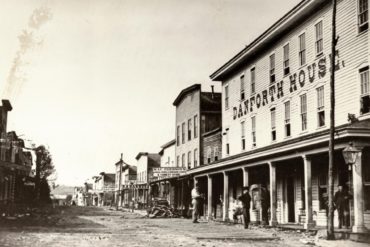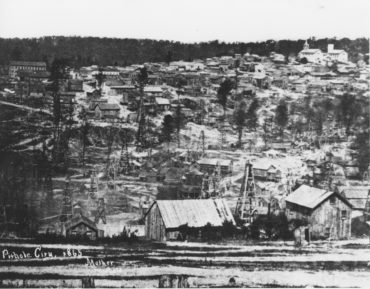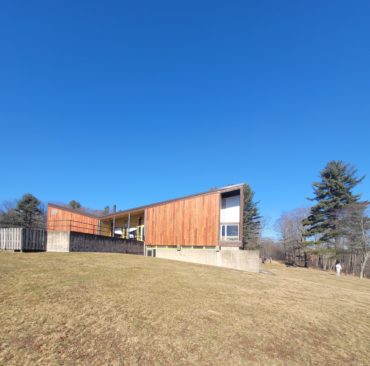Historic Pithole City

The Visitor Center at Pithole is CLOSED for the season*. It will reopen the weekend of June 6 and 7, 2026.
Upcoming Special Events at Pithole:
- Cabin Fever Party, February 7, 2026 - time & details TBA, visit our main Events Page for updates!
*The outside grounds at Pithole are free to explore on your own and are open from dawn to dusk, year-round. Paid guided tours of the outside grounds are available upon request during regular Visitor Center hours of operation.
What are the hours and admission rates for Historic Pithole City? The Pithole Visitor Center is open for visitors from June through August on Saturdays and Sundays, 10 AM to 4 PM. Admission to the Visitor Center is $5 for Adults and $3 for Youth ages 3-11. Children ages 2 and under are free. The outside grounds are open every day, year-round, from dawn to dusk and do not require an admission fee. Guided tours of the outside grounds are available upon request on days when the Visitor Center is open; paid admission is required for guided tours of the outside grounds.
Where is Historic Pithole City located? This historic site is located at 14118 Pithole Road, Pleasantville, PA 16341, just off PA Route 227 (south of Pleasantville and north of Rouseville). It can also be accessed from PA Route 36 (north of Tionesta and just south of its terminus at Pleasantville). The GPS coordinates of Pithole are: 41.520662, -79.586201.
Is Historic Pithole City accessible for wheelchairs? The first floor of the Pithole Visitor Center is wheelchair accessible. It features the main entrance, all of the indoor exhibits, the film theater, and the diorama, as well as an accessible restroom. The second floor of the Visitor Center only features additional non-wheelchair accessible restrooms. The outside grounds are not easily accessible for wheelchairs due to the natural terrain. A golf cart is available to take visitors on an outside tour but is limited to carrying up to three (3) people at a time. The golf cart can be reserved for tours at the Visitor Center when open to the public.
What is inside the Visitor Center? The Pithole Visitor Center includes the 15 minute orientation film Pithole USA along with a brief guided introduction of the history of Pithole City and its significance to the early petroleum industry in Pennsylvania. Visitors will also receive a guided interpretation of the Pithole City diorama, providing a glimpse at what Pennsylvania's legendary oil boomtown would have looked like in its heyday! In addition to the diorama, there are also displays and exhibits to explore inside the Visitor Center!
Where can I find more info on Historic Pithole City events and living history demonstrations? Historic Pithole City hosts special events throughout the year including living history demonstrations on select weekends during the summer, Lantern Tours in October, and the Cabin Fever Party in February. For more information on these events, please visit our main Events page!
Who owns and operates Historic Pithole City? Historic Pithole City is administered by the Pennsylvania Historical and Museum Commission in partnership with Friends of Drake Well, Inc. For questions or more information contact Drake Well Museum at (814) 827-2797.
What is the history of Historic Pithole City, and why is it significant? Pithole City is known in the Pennsylvania Oil Region as the oil boomtown that vanished as quickly as it appeared. News of the successful Frazier Well along Pithole Creek was widely published in the nation’s newspapers in January 1865. Boarding houses, hotels, and businesses of all kinds went up overnight. More big wells were struck during the summer of ’65, and people came from all directions in hope of making a better life after 5 years of bitter war and strife in the United States. Oil drillers and speculators, gamblers and business owners, and women and men looking for work made up the 15,000 people living in the area by that fall.
Oil wells filled the Pithole Creek Valley producing more than 5,000 barrels of oil a day for a while. Thousands of teamsters hauled the barrels of oil to the nearest railroad depot at Miller Farm in the Oil Creek Valley. The city boasted a foundry and machine shop, the 3rd busiest post office in Pennsylvania, and every type of business and entertainment house imaginable. Banks handled tens of thousands of dollars in transactions daily.
But fortune was fleeting. Oil prices fell from $8.00 a barrel to $2.50. Samuel Van Syckel’s pipeline opened in the fall of 1866 putting thousands of teamsters out of work. Seventeen disastrous fires burned wells, businesses, and boarding houses causing an unknown number of injuries and death. People moved to new oil fields and boomtowns leaving less than 2,000 people in the once thriving city by December 1866. In the fall of 1870, only 43 households and 1 hotel remained. The Pithole City charter was revoked in February 1877, and the land was sold to a farmer at sheriff’s sale.
Later, in 1963, landowner James B. Stevenson gave 90 acres of the former city to the Commonwealth of Pennsylvania, and the Pennsylvania Historical and Museum Commission opened a visitor center there in 1975. Today, a large diorama shows the city in its heyday with over 200 miniature buildings, the streets, and around 500 figures. Exhibits and a film tell the story of the rise and fall of the famous boomtown. While walking the grounds, visitors have the chance to read the interpretive and directional signage along the city streets and imagine the boomtown as it was in the mid-1860s.





